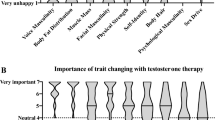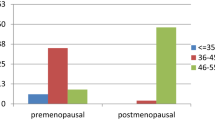Abstract
Previous studies demonstrated that there is a significant change in speaking fundamental frequency after testosterone therapy in female-to-male gender dysphoric individuals. It is yet an open question how the satisfaction with voice alteration can be predicted because until now it is not clear whether a testosterone therapy is sufficiently effective. The aim of the current study was not only to measure satisfaction with voice, but additionally to detect factors that predict or explain satisfaction with voice after testosterone therapy. Therefore, nine female-to-male gender dysphoric individuals were examined during the first year of testosterone treatment at different points of time. The patients underwent several voice analyses within 1 year and had to fill out several questionnaires concerning their voice, depressive symptoms, quality of life and voice handicap index. Multiple regression analyses were performed to find the factors that explained satisfaction with altered voice after 1 year. The difference of voice frequency in semitones before the treatment and after 1 year is the only significant predictor for satisfaction after 1 year (B = 0.442; SE = 0.049) and more important than the absolute fundamental frequency.

Similar content being viewed by others
References
Neutze J, Beier KM (2006) Die Bedeutung der Stimme für die menschliche Sexualität. Sexuologie 13:38–66
World Health Organisation. International Classification of Diseases (ICD) Version 2014. http://apps.who.int/classifications/icd10/browse/2015/en#/F64.0. Accessed 09 January 2016
American Psychiatric Association (2013) Diagnostic and statistical manual of mental disorders, 5th edn. American Psychiatric Association, Arlington, VA
Hembree WC, Cohen-Kettenis P, Delemarre-van de Waal HA, Gooren LJ, Meyer III WJ, Spack NP, Tangpricha V, Montori VM, Endocrine Society (2009) Endocrine treatment of transsexual persons: an endocrine society clinical practice guideline. J Clin Endocrinol Metab 94:3132–3154
Cosyns M, Van Borsel J, Wierckx K, Dedecker D, Van de Peer F, Daelman T, Laenen S, T’Sjoen G (2014) Voice in female-to-male transsexual persons after long-term androgen therapy. Laryngoscope 124:1409–1414
Van Borsel J, De Cuypere G, Rubens R, Destaerke B (2000) Voice problems in female-to-male transsexuals. Int J Lang Commun Disord 35:427–442
Sandmann K, Am Zehnhoff-Dinnesen A, Schmidt CM, Rosslau K, Lang-Roth R, Burgmer M, Knief A, Matulat P, Vauth M, Deuster D (2014) Differences between self-assessment and external rating of voice with regard to sex characteristics, age and attractiveness. J Voice 28:128.e11–128.e18
Zäske R, Skuk VG, Kaufmann JM, Schweinberger SR (2013) Perceiving vocal age and gender: an adaption approach. Acta Psychol (Amst) 144:583–593
Gelfer MP, Mikos VA (2005) The relative contributions of speaking fundamental frequency and formant frequencies to gender identification based on isolated vowels. J Voice 19:544–554
Deuster D, Matulat P, Knief A, Zitzmann M, Rosslau K, Szukaj M, am Zehnhoff-Dinnesen A, Schmidt CM (2015) Voice deepening under testosterone treatment in female-to-male gender dysphoric individuals. Eur Arch Otorhinolaryngol 273:959–965
Damrose EJ (2009) Quantifying the impact of androgen therapy on the female larynx. Auris Nasus Larynx 36:110–112
Nygren U, Nordenskjöld A, Arver S, Södersten M (2015) Effects on voice fundamental frequency and satisfaction with voice in trans men during testosterone treatment—A longitudinal study. J Voice. doi:10.1016/j.jvoice.2015.10.016
Dejonckere PH, Bradley P, Clemente P, Cornut G, Crevier-Buchman L, Friedrich G, Van De Heyning P, Remacle M, Woisard V, Committee on Phoniatrics of the European Laryngological Society (ELS) (2001) A basic protocol for functional assessment of voice pathology especially for investigating the efficacy of (phonosurgical) treatments and evaluating new assessment techniques. Guideline elaborated by the Committee on Phoniatrics of the European Laryngological Society (ELS). Eur Arch Otorhinolaryngol 2:77–82
Beck AT, Steer RA, Brown GK (1996) Manual for the beck depression inventory-II. Psychologcial Corporation, San Antonio
Ware JE Jr, Kosinski M, Keller SD (1996) A 12-item short-form health survey: construction of scales and preliminary tests of reliability and validity. Med Care 34:220–233
Nawka T, Wiesmann U, Gonnermann U (2003) Validation of the German version of the voice handicap index. HNO 51:921–930
Greenhouse SW, Geisser S (1959) On methods in the analysis of profile data. Psychometrika 24:95–112
Mauchly JW (1940) Significance test for sphericity of a normal n-variate distribution. Ann Math Stat 11:204–209
Zäske R, Volberg G, Kovács G, Schweinberger SR (2014) Electrophysiological correlates of voice learning and recognition. J Neurosci 34:10821–10831
Zimmermann A, Zimmer R, Kovacs L, Einödshofer S, Herschbach P, Henrich G, Tunner W, Biemer E, Papadopulos NA (2006) Lebenszufriedenheit transsexueller Patienten nach geschlechtsangleichenden Operationen. Chirurg 77:432–438
Author information
Authors and Affiliations
Corresponding author
Ethics declarations
Ethical considerations
The study was approved by the local Ethics Committee of the local Medical Association (Ärztekammer Westfalen-Lippe, Germany) and the Medical Faculty Münster, Germany. All procedures performed in this study involving human participants were in accordance with the 1964 Helsinki declaration and its later amendments or comparable ethical standards. Informed consent was obtained from all individual participants included in the study.
Conflict of interest
None to declare.
Financial disclosure
None to report.
Additional information
D. Deuster, K. Di Vincenzo contributed equally to this work.
Rights and permissions
About this article
Cite this article
Deuster, D., Di Vincenzo, K., Szukaj, M. et al. Change of speech fundamental frequency explains the satisfaction with voice in response to testosterone therapy in female-to-male gender dysphoric individuals. Eur Arch Otorhinolaryngol 273, 2127–2131 (2016). https://doi.org/10.1007/s00405-016-4043-0
Received:
Accepted:
Published:
Issue Date:
DOI: https://doi.org/10.1007/s00405-016-4043-0




